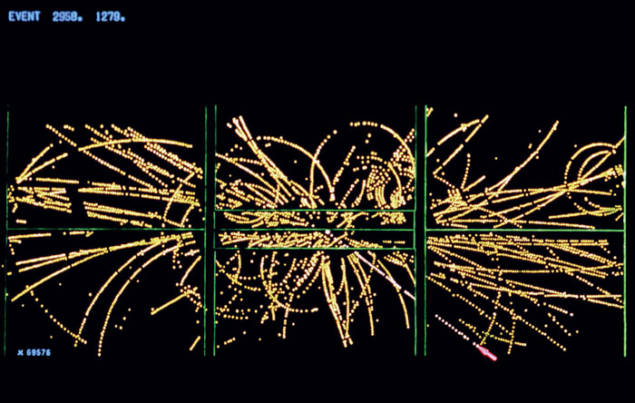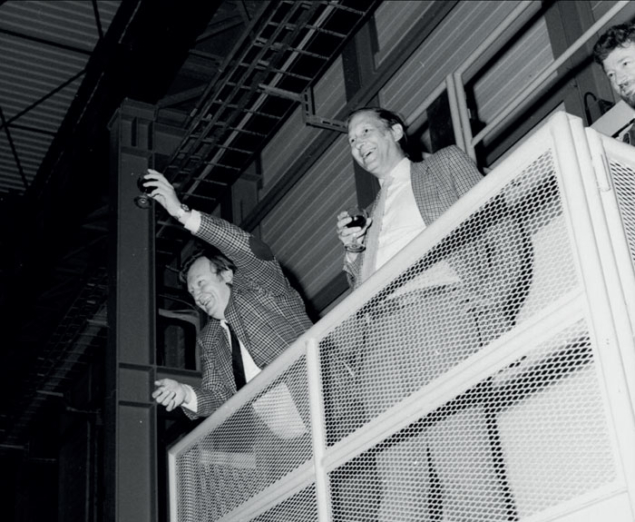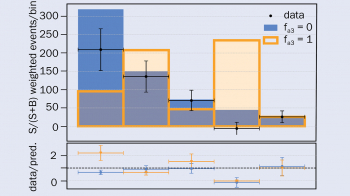Lalit Sehgal experienced an increased curiosity in electroweak physics at CERN in the weeks leading up to the discovery of the W and Z bosons.

In the autumn of 1982, I was invited to give a series of seven lectures at CERN under the title “Electroweak Interactions”. These were part of the Academic Training Programme, which was aimed at young experimenters working on projects at CERN. The lectures were to be given on successive days on 18–26 November, excluding the weekend of 21–22 November. I had given seminars at CERN on earlier occasions and the response had always been positive. Giving seven lectures in a row could be stressful but at least the subject was in my own domain. I expected the number of people attending to be between 50 and 100.
When I arrived to give my lecture on the first day, I was astonished to see that the auditorium was chock-full of people. (Somebody mentioned later that the number was 400.) For a moment I thought that I had wandered into the wrong auditorium. Seated in the first row were stalwarts of CERN, such as Rolf Hagedorn, Jacques Prentki, Maurice Jacob and André Martin. I could see in the crowd several experienced people whom I knew from the heyday of neutrino physics. It was not at all the kind of audience that I had expected. I began to wonder what I could tell them that they had not heard a dozen times before.
A bold venture
When the opening lecture ended I hastened to return to the dormitory to prepare my second talk. On the way I saw Jack Steinberger, one of the veterans of CERN, for whose course I had once acted as a tutor. I told him that I had come to CERN to give Academic Training lectures and he said, with dismay: “I know that. I looked for my people this morning and there was nobody around, because they had all gone to your lecture.”
That evening I went to the CERN cafeteria for a coffee and there I saw something that I had not noticed before. There was a monitor on the wall and people were watching the screen with great interest. The monitor was showing the rate of proton–antiproton collisions in CERN’s latest challenge – a bold venture designed to produce the intermediate bosons, W and Z. These bosons were predicted by electroweak theory to occur at masses of 80 GeV and 90 GeV, respectively. The synchrotron at CERN that accelerated protons to 400 GeV was, by itself, not capable of producing such massive particles. So CERN had built a smaller ring in which antiprotons produced in conventional proton interactions were accumulated. These antiprotons were compressed to compact beams, then accelerated to 270 GeV in the Super Proton Synchrotron and finally brought into head-on collision with 270 GeV protons. And this audacious idea appeared to be working! The collision rate was low but it was climbing from hour to hour. Now I understood the reason for the crowd in my lecture. CERN was on the way to testing the crucial prediction of electroweak theory, namely the existence of intermediate bosons with masses and properties that were precisely predicted. A confirmation of this prediction would be a triumph for CERN and would probably bring the laboratory its first Nobel prize.
I returned to my room in the dormitory and resumed the writing of my overhead transparencies. I now knew that my lectures would have to focus on precisely the questions that the physicists at CERN would be interested in: the cross-sections for W and Z production; the expected event rates; the angular distribution of the W and Z decay products, etc. People would also want to know how uncertain the predictions for the W and Z masses were and why certain theorists (J J Sakurai and James Bjorken among them) were cautioning that the masses could turn out to be different. The writing of the transparencies turned out to be time consuming. I had to make frequent revisions, trying to anticipate what questions might be asked. To make corrections on the film transparencies, I was using my after-shave lotion, so that the whole room was reeking of perfume. I was preparing the lectures on a day-by-day basis, not getting much sleep. To stay awake, I would go to the cafeteria for a coffee shortly before it closed. Thereafter I would keep going to the vending machines in the basement for chocolate – until the machines ran out of chocolate or I ran out of coins.
After the fourth lecture, the room in the dormitory had become such a mess (papers everywhere and the strong smell of after-shave) that I decided to ask the secretariat for an office where I could work. Office space in CERN is always scarce but they said I could use the office that was previously occupied by Sakurai. At that point I recalled, with sorrow, his tragic and totally unexpected death that I had read about some weeks earlier. I had forgotten that he was a visitor at CERN at the time. I had high regard for him as a physicist. There was a period of some years when we were doing parallel things in connection with the structure of neutral currents. He was always fair and correct in attributing credit and was an excellent lecturer. I had met him quite recently at the Neutrino ’82 Conference in Balatonfüred and at the 1982 International Conference on High-Energy Physics in Paris. When the secretary opened the office for me, many of Sakurai’s books and papers were still in the room. Lying on his desk were a couple of preprints that he had been reading on his last day at the office. I felt uncomfortable about disturbing that scene by bringing in my own papers and I told the secretary that I would continue to work in the dormitory.
Champagne times
The lectures went well. The attendance declined after I had finished with the discussion of intermediate bosons (vector quanta) and Higgs particles (scalar quanta). On the eve of the last lecture, I went rather late to the CERN cafeteria for dinner. The place was almost deserted. I saw that there was one corner that had been screened off for a private get-together. There were sounds of a party, with clinking glasses and the pop of a champagne bottle. Glancing inside the screen, I saw Steinberger and a number of American visitors at CERN. I realised that it was Thursday and they were celebrating Thanksgiving. For a moment I had a desire to join them but my natural diffidence held me back. As I was about to leave, one person emerged from the enclosure. It was Gary Feldman from SLAC. He greeted me and said: ” I have been attending your lectures. What are you going to talk about tomorrow?” When I said CP violation he said: “What a shame. I should have loved to hear that but I have to leave in the morning.” He wished me luck.

Before leaving the cafeteria, I glanced at the monitor showing the status of the beams in the collider. The luminosity was still rising. The next morning, after my final lecture, I went over to the analysis room of the UA1 experiment in which physicists from Aachen were participating. They showed me a couple of events that were candidates for the W and Z. It seemed that CERN would have occasion to open champagne bottles, before too long.
I returned to Aachen quite exhausted. I resolved not to give so many lectures again (they had asked for only four/five). I also resolved not to use after-shave as a correcting fluid. But it had been a satisfying visit. I had come to CERN at a time full of suspense. There was a scent of discovery in the air.
On 25 January 1983, eight weeks after my return, CERN held a press conference to announce the discovery of the W boson. The announcement of the Z boson followed on 1 June








